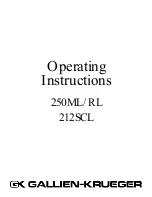
Operating Manual - nX, nXe, and nXp Power Amplifiers
48
12 AES3 DIGITAL AUDIO INPUT/PASS-THROUGH
nXe and nXp amplifiers support factory installed two or four channel
AES3 input options, named OPAES2* and OPAES4*. The AES3 format
uses two channels of digital audio transmitted over a single cable, main
-
taining a completely digital signal path into the amplifier stage or into
the DSP stage if DSP is installed. Two channel amplifiers accept a two
channel input with pass-through, while four channel amplifiers accept
four input channels with pass-through. There is no AES3 output avail
-
able from the amplifier's DSP section, only pass-through of the input.
48kHz and 96kHz AES3 data rates are currently supported. The amplifier's
internal sample rate must match the incoming AES3 sample rate
. A bicolor LED beside the AES3 connector indicates "Lock" (green)
or "Error" (red) as long as the AES3 receiver is active
and
is providing the
master clock source. The software AES3 control panel (shown below) shows
the status of the AES receiver in greater detail.
12.1 Source Selection
The input must be configured via software to
accept the AES3 source before it can be used. See
.
12.2 Cable Specification
Standard 110 ohm microphone cable (3
conductor) with standard XLR connectors will support AES3 data transmission up to 100 meters.
12.3 Hardware Status Indicators
AES Status LED (green)
- Receiver Rx1 is "Active", has locked onto an incoming AES/EBU signal, and data is ready for
processing.
This LED is disabled when network audio provides the master clock.
AES Status LED (red)
- Receiver Rx1 is "Active" but has an error. AES Signal will be muted.
See "Errors Since Reset" for specific error.
12.4 Software Status Indicators
The AES/EBU status is found under the Device
Options>DSP Options menu:
AES3 Input Status (green):
Receiver is "Active" and has locked onto an incoming AES/EBU
signal and data is ready for processing.
AES3 Input Status (red):
Receiver is "Active" and has an error. See "Errors Since Reset"
for specific error.
Detected Sample Rate:
Sample rate at which the AES/EBU receiver is locked.
Errors Since Reset:
This displays AES3 data errors that have occurred during run time. Error
indications are latching, meaning they remain on even after the error condition has been cor-
rected, useful when diagnosing intermittent problems. Error indications are cleared by pressing
[Reset Errors] or by cycling power.
AES/EBU Parity Error:
Parity error with incoming signal
AES/EBU Non-Audio Error:
Incoming signal is not audio
AES/EBU Sample Rate:
Unable to lock onto incoming frequency
AES/EBU Invalid Error:
Incoming signal is invalid
AES/EBU Lock Loss Error:
Unable to lock onto incoming signal, or lost lock of incoming signal
AES/EBU Sample Rate Mismatch:
Receiver frequency does not match DSP frequency.
AES/EBU Non-PCM Error:
Invalid AES format
*To use an OPAES2 or OPAES4 option in an nXe amplifier (no DSP), the OPDAC4 must also be ordered and installed by the
factory. The OPDAC4 is not required on nXp models.
OPAES2 and OPAES4 AES3 Options
AES3 Software Control Panel













































